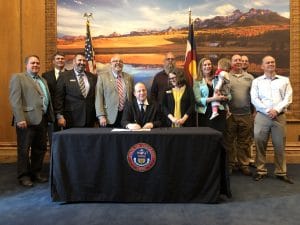The disastrous flooding in the Midwest has affected thousands of people, including SMART Transportation Division members.
To help assist those who have had their lives affected by the floods, Your Track to Health has compiled a list of services and information for behavioral health, prescription providers, vision, dental and health insurance resources and counseling.
To see the entire list, visit this link.
Author: bnagy
A decision by the U.S. Supreme Court found that the portion of a damages award attributable to lost wages for a workplace injury is considered to be taxable compensation under the Railroad Retirement Tax Act (RRTA). The decision in BNSF Railway Co. v. Loos (No. 17-1042) was released March 4.
Michael Loos pursued a claim against his then-employer, BNSF, for a workplace injury under the Federal Employers’ Liability Act (FELA), a law allowing railroad workers to file suit against their employers for on-the-job injuries. Loos was awarded damages of $126,212, of which $30,000 was attributable to lost wages from BNSF. BNSF indicated that it would withhold railroad retirement taxes from the lost wages portion of the award. Loos disagreed with this theory of withholding, arguing that, consistent with the RRTA’s definition of compensation, the payment must be “for services rendered” in order to be taxable and instead of compensation for services rendered the payment at issue compensated for an injury.
The issue worked its way from the lower courts to the Supreme Court. Oral arguments took place on November 6, 2018, and the court reached its decision on a 7-2 vote. In reversing the decision of the Circuit Court of Appeals for the Eighth Circuit, the Supreme Court held that the RRTA’s definition of compensation includes not simply pay for active service, but also “pay for periods of absence from active service provided there is an employer-employee relationship.” Whether the employer chooses to make the payment through a voluntary settlement or is involuntarily made to do so through an award of damages is immaterial so long as the payment for lost wages is provided based on the recipient’s status as a service-rendering employee.
The Internal Revenue Service administers the RRTA and, therefore, is the official source for Railroad Retirement tax information.
However, for purposes only of illustrating the court’s decision, the following example is provided.
In 2019, railroad employers and employees are subject to a Railroad Retirement tier I payroll tax of 7.65 percent (6.20 percent on earnings up to $132,900 for retirement, and 1.45 percent on all earnings for Medicare hospital insurance) and a tier II tax of 13.1 percent and 4.9 percent, respectively, on earnings up to $98,700. (An additional 0.9 percent in hospital insurance taxes, 2.35 percent in total, applies to an individual’s income exceeding $200,000, or $250,000 for a married couple filing a joint tax return).
If a railroad employee with no other earnings in 2019 is awarded $550,000 due to an on-the-job injury, of which $200,000 is attributable to lost wages (both past and future), the employer and employee would be required to pay $11,139.80 in tier I taxes ($8,239.80 retirement and $2,900 Medicare) and $12,929.70 and $4,836.30, respectively, in tier II taxes. (The additional Medicare tax would not apply as the award for lost wages did not exceed $200,000).
Born in 1930, Art Hanford began his railroad career as a darkroom technician for the Chesapeake & Ohio (C&O) Railway in 1953. While with the C&O, he earned a reputation as a quality photographer and writer. He was a trusted employee of Cyrus Eaton, the C&O Board Chairman at the time, and accompanied him on many trips to The Greenbrier Resort, then owned by the railroad, in White Sulfur Springs, WV.
In 1958 he went to work for the Brotherhood of Locomotive Engineers (BLE) as photographer-reporter and continued to earn credit for his work on the union’s publications. During this time, Art spent many years working with the BLE Grand Chief, Guy Brown. At that time, the BLE had over 60,000 members.

Early in 1967, Art moved to Chicago as managing editor of Railway Purchasing & Stores, one of several magazines, including Railway Age, published by Simmons Boardman.
Later that same year, Art accepted a position back in Ohio from the Brotherhood of Railroad Trainmen as Assistant Editor of Trainman News, the official BRT member publication. Charles Luna was president at the time.
In 1969, the BRT merged with three other rail unions to form the United Transportation Union, where Luna was named the new union’s president. In 1971, Al Chesser became Luna’s successor as president of the UTU until 1979, who was then followed by Fred Hardin (until 1991).
Art Hanford retired in 1990, with his last held position being the UTU’s Director of Internal Communications. At that time, the union had approximately 90,000 members.
Among the most memorable trips for Art were those traveling with engineers on steam locomotives, which were fast disappearing. He was also assigned to take pictures of Queen Elizabeth II in 1959 on a Royal train trip through Canada. Other celebrities he photographed in his career were Ben Hogan while playing in a golf tournament at the Greenbrier.
Art wrote several books after he retired, including a yet-to-be-published autobiography titled “Writing on the Railroad.” Art’s son, Guy Hanford, indicated that the family plans to finish publishing the book in honor of their father.
Art Hanford died peacefully surrounded by his family on Friday, March 15, 2019. He is survived by his wife Janice of 66 years.
Pursuant to Title 49 of the Code of Federal Regulations (CFR) § 211.45, Federal Railroad Administration Administrator Ronald L. Batory has determined that the extreme flooding currently occurring throughout the Midwest United States constitutes an “emergency event” as related to railroad operations.
In making this determination, the Administrator notes that the National Weather Service has issued flood warnings for areas throughout the Midwest and documented historic flooding throughout the region with rivers rising to historic levels in over 40 locations, causing power outages and breached dams and levees. The large amounts of snow and ice resulting from the region’s recent winter weather have melted and swelled rivers, creeks and other inland bodies of water throughout the region.
The Administrator also notes that a multitude of local governments have declared emergencies related to the flooding. Therefore, the Administrator has activated the Emergency Relief Docket (FRA-2019-0001) as of March 19, 2019 and the emergency relief provisions of 49 CFR § 211.45 are in effect.
To better understand and evaluate the use of certain technologies implemented by carriers, SMART Transportation Division is seeking information regarding the operation of the technologies such as Positive Train Control, Trip Optimizer/Leader and others.
In order for our organization to formulate a plan to protect members and the general public and to ensure the safety of the nation’s infrastructure, we are asking members to provide information when incidents or events occur that involve these technologies failing.
“By reporting these events, we can track these instances and find any trends that may be occurring with these technologies,” said Jared Cassity, alternate director — East for the SMART TD National Safety Team and Kentucky’s state legislative director.
On the right side of the main page of the SMART Transportation Division website, an electronic form for members to report a railroad technology event is linked in the box labeled “Railroad Technology Event Report.”
Reports submitted through this form go to union safety leadership for collection. These reports are not a substitute for filling out a report to a carrier or to the Federal Railroad Administration (FRA).
WASHINGTON – The U.S. Department of Transportation’s Federal Transit Administration (FTA) announced March 18 that the 31 State Safety Oversight (SSO) programs in 30 states have been certified in advance of the April 15, 2019, safety deadline.
“Safety is the department’s top priority, and we are pleased that all states have met certification requirements and are providing more rigorous state safety oversight of federally funded rail transit systems,” said U.S. Secretary of Transportation Elaine L. Chao.
Changes in federal public transportation law required states to strengthen the oversight of rail transit systems. The SSO Final Rule included a three-year compliance deadline and applied to federally funded rail fixed guideway public transportation systems such as heavy rail, light rail, monorail and streetcar systems.
“The hard work of state agencies and our shared commitment to improving the safety of our nation’s rail transit systems has been a driving force to establish stronger state safety oversight,” said FTA Acting Administrator K. Jane Williams.
To assist states in meeting the enhanced safety provisions, federal law authorized a formula grant program. Since 2013, FTA has provided approximately $136.1 million to eligible states to develop and implement a SSO Program compliant with federal requirements.
To achieve FTA certification, a SSO program had to meet several federal statutory requirements, including establishing a SSO agency that is financially and legally independent from the rail transit agencies it oversees. In addition, a state had to ensure that its SSO agency adopts and enforces relevant federal and state safety laws, has investigatory authority, and has appropriate financial and human resources for the number, size and complexity of the rail transit systems within the state’s jurisdiction. Furthermore, SSO agency personnel responsible for performing safety oversight activities had to be appropriately trained.
If a state had failed to meet the deadline, FTA would have been prohibited by law from awarding any new federal transit funds to transit agencies within the state until certification was achieved.
The AFL-CIO’s Transportation Trades Department (TTD) on March 11 announced the railroad industry issues that the coalition of transportation unions, of which SMART Transportation Division is a member, will prioritize in the coming months.
Of the highest importance, the policy statement identified continuing the progression of safety measures, including national legislation.
“More can and must be done to further improve safety, minimize risk on railroads, and ensure frontline workers and the communities they operate in are fully protected,” the TTD said in its policy statement. “By reauthorizing the now-expired Rail Safety Improvement Act of 2008 (RSIA), closing perilous loopholes in existing regulations, and advancing common sense safety regulations that prioritize a vibrant and healthy rail workforce, Congress and the administration have an opportunity and obligation to ensure that the future of rail is safer than ever before.”
The policy statement also identified five key points of focus:
- Addressing Fatigue with Common Sense Solutions
- Single Crew Member Trains are Unsafe
- Protecting Rail Workers from Assault
- Ensure Cross Border Safety and Security
- Working Together for a Safe and Risk Free Rail Industry
“Rail workers cannot be expected to do more with a reduced workforce, fewer resources, and less sleep while simultaneously improving safety and minimizing risks,” the TTD concluded. “Rail labor will work vigorously with Congress to ensure adequate safety measures are implemented through the reauthorization process and will challenge any attempts that are made at the expense of safety, workers’ rights and their jobs.”
The policy statement was released in conjunction with the TTD’s Executive Committee meeting in New Orleans.
Read the full policy statement.
The Washington State Legislative Board had some good news to report this week about its effort to get two-person crew legislation passed in the state.
“For six consecutive years, we have doggedly pursued passage of this critical public safety bill. Today, for the first time we advanced train crew size legislation to the floor of the full House for a vote,” Washington State Legislative Director Herb Krohn reported. “House Speaker Frank Chopp personally presided over the chamber for this historic vote.”
The bill, H.B. 1841, passed, 72-24 (with two excused absent members), on March 13, marking the first time the Washington House of Representatives has OK’d final passage of train crew size legislation, Krohn said.
The passage marks the halfway point of efforts to get the legislation passed in Washington state. It next needs passage in the state’s Senate before heading to the governor’s desk.
“This year, the carriers have waged the most aggressive campaign ever against all of our rail safety bills,” Krohn said. “We can expect they will turn the heat up even higher and expend even greater resources in opposition as the bill is considered by the state Senate.
“It will continue to require dogged persistence along with considerable efforts on our part to overcome the organized business coalition the railroad carriers have strung together in their quest to block us from moving crewing legislation across the finish line into state law.”
To get aboard the Washington State Legislative Board’s efforts to get this legislation passed, visit the board’s website, or link to them on Facebook.


